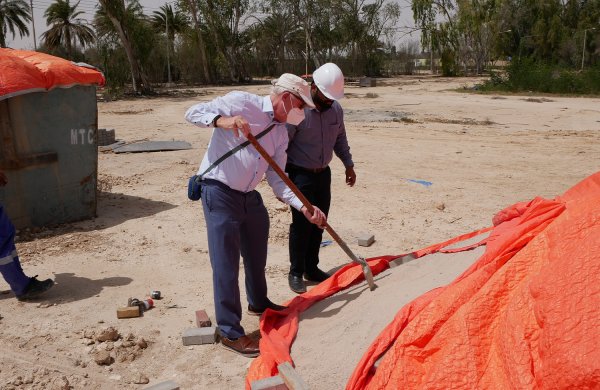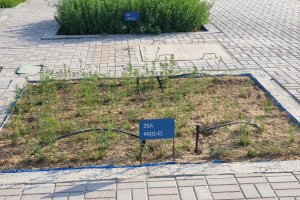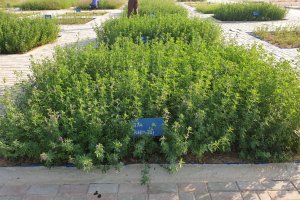
Longread
AquaConnect for purification of salt, brackish, waste water and the retention of storm water
AquaConnect focusses on the purification of salt water, brackish water and wastewater, but also on the retention of storm water. In which abundant rainwater, which now mostly drains into surface water and then into the sea, is reused. “We would like to collect this storm water or allow it to infiltrate the soil for later use”, says Rijnaarts, Professor of Environmental Technology at Wageningen University & Research.
“In view of climate change, these options will become increasingly important. In AquaConnect we’re also looking at the regulations the government needs, to allow and control the use of cleaned wastewater and brackish water. Together with the universities of Utrecht and Amsterdam, it is being studied how these regulations can be incorporated into the new environmental law that will apply in the Netherlands and the water directives of the European Union.”
Read the related news item:
Before AquaConnect
Water Nexus is the predecessor of AquaConnect. A large-scale research programme coordinated by Wageningen University & Research. It focussed on questions such as how to use salt water for irrigation or for industrial processes and how to efficiently reuse industrial wastewater and which technologies are needed for this. The programme ended in the final trimester of 2021.
Rijnaarts: “Water is increasingly a scarce resource – not only in hot climates, but also in the Netherlands. Climate change will only increase the risk of water scarcity in the future. This may lead to shortages in drinking water supply, agriculture, nature and industry. “In the battle for water, there’s always competition between these sectors. We were wondering how we can make these sectors less competitive and how science might contribute to this. In other words, can we develop alternative sources of water?”
Interdisciplinary approach
There are two main options available: you can either tap into new sources from the environment, such as salt or brackish water, or you can reuse industrial wastewater. “Companies in the chemical industry and the oil and gas sector often produce a lot of excess water”, explains Rijnaarts. “This water is usually discharged directly into the sea – which is a waste of a potential water supply.”

Wageningen joined forces with large multinationals, small and medium-sized enterprises, consultancy firms, universities, applied knowledge institutions, drinking water companies, technology suppliers, water boards and the Ministry of Infrastructure and Water Management. Together they submitted an application to the Dutch research funding body NWO. “The application was approved and in 2015 we got the go-ahead with a budget of 6.5 million euros.”
Benelux and abroad
Two important case studies were central to Water Nexus. The first was Dow Benelux, a large chemical factory in Terneuzen with a water requirement of 25 million cubic metres per year. The second was the reuse of industrial wastewater in the Middle East, in collaboration with Shell in Qatar and Oman. There too, wastewater flows into the sea, while the desert is subject to systematic drought. Rijnaarts: “In these regions reused water may be used for greening the desert and for growing crops such as sisal and cotton.”
A third component of Water Nexus was a ‘twinning programme’. Through the NWO research programme Urbanising Deltas of the World, Water Nexus was linked to a project in Vietnam called ENTIRE. “We received an extra 1.2 million euros to apply the concepts developed in Water Nexus in business parks there as well. It’s great to see that the knowledge isn’t just useful for the Netherlands, but for emerging economies too.”
Three important questions
Water Nexus addressed three main questions: Does this area harbour any salt, brackish and fresh water reserves, and how can we access and manage these? Which technologies are needed for this? And how can we draw up a system design for the water needs of this industry and its environment, based on closed cycles and local water sources? “We worked together with various partners on each of those questions”, says Rijnaarts. “They are the ones who will develop the technology for the market.”

For the first challenge, the researchers combined radar technology with geological data on the subsurface. “We did this together with TNO, Utrecht University and Deltares”, says Rijnaarts, “and particularly in the province of Zeeland, which often experiences freshwater shortages. As drought is likely to occur more often in the future, this knowledge is crucial for the development of industrial water systems that are in balance with their environment.”
Micro-organisms tolerant to salt water
The second question, on the required technologies, mainly concerned microbiology. Water is purified by bacteria in large bioreactors. They use the harmful organic compounds as a food source and convert them into harmless substances. “One problem is that many bacteria in these bioreactors are not very tolerant to salt water”, says Rijnaarts. “Together with the Laboratory of Microbiology at Wageningen University & Research, the Delft University of Technology and a number of companies, we have grown bacteria that are more salt-tolerant.”
In doing so, the researchers discovered a yet unknown mechanism by which bacteria can protect themselves against salt. Inside and outside their cells, bacteria can produce certain organic salts, or osmolytes, to give counter-pressure against the salt from the surrounding water. This prevents cell death from water loss. “This is also very interesting from a fundamental point of view”, says Rijnaarts. “Our research has not only a direct application, but it’s also very inspiring and innovative from a scientific point of view.”
Lysimeters with buffalo lyegrass and alpha alpha. Those lysimeters measure the ratio of soil to water.
The researchers have also developed new combinations of natural and technological purification systems. “The basis of this concept is a constructed wetland containing plants and micro-organisms that purify the water”, continues Rijnaarts. “Only these wetlands are less able to remove certain chemicals in industrial wastewater and not resistant to too high salt concentrations. Our project also developed new membranes that remove chemicals and salt. We have tested this combination of technologies in practice and it works.”
A new system design
For the third component, a systems approach, Water Nexus researchers developed new modelling techniques to calculate the most effective water infrastructure, such as pipelines. “These are advanced computer models with which you can analyse millions of variants and then select the most favourable ones”, explains Rijnaarts. “For the Dutch Flanders region, where we found fifty water extraction locations for sweet and brackish water, we calculated the potential yield without damaging agriculture or nature, the need for transport infrastructure and the costs involved.”
Inspirational new period
The results of this component, a smart water grid, have yet to be translated into practice. “We are going to do that in AquaConnect”, says the professor. “The program will partly continue with the same parties as Water Nexus, but also with new knowledge partners and local stakeholders such as drinking water companies, provinces, municipalities and water boards. We will develop alternative water supplies for the western Netherlands and the higher sandy soils in the eastern Netherlands, partly on the basis of the output supplied by Water Nexus. I am very excited. We have an interesting and inspiring new period ahead of us.”

